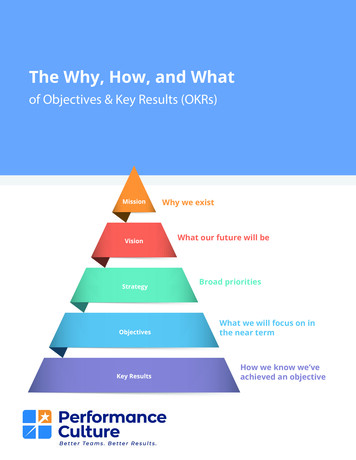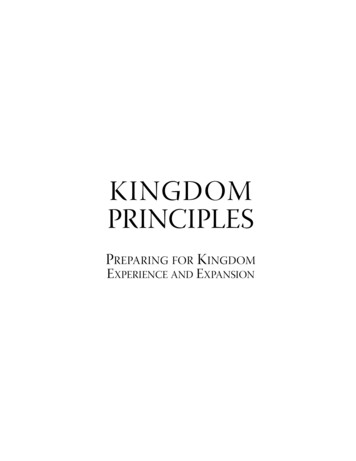
Transcription
The Why, How, and Whatof Objectives & Key Results (OKRs)Why we existWhat our future will beBroad prioritiesWhat we will focus on inthe near termHow we know we’veachieved an objective
Table of Contents01. What are Objectives and Key Results402. Business Challenges and Why You Need OKRs803. Creating Powerful OKRs1304. Aligning, Driving, and Measuring OKRs Successfully1705. Common Mistakes and How to Deal With Them2206. Zalando Case Study2407. OKRs Cheat Sheet26The Why, How, and What of Objectives & Key Results (OKRs) 2020 Performance Culture, Inc.Page 2
01What areObjectives andKey Results
A man was walking next to a building site and saw three stonecutters there. The man wantedto know what it was all about so he went to ask the stonecutters. He asked the first stonecutterwhat he was doing and the stonecutter responded “Making a living.”The man walked past him and went to the second stonecutter toask him what he was doing. He responded, “I’m doing the best jobof stone cutting in the entire country.” The man then went alongto ask the third stonecutter what he was doing and he respondedconfidently “I’m building a cathedral.”The first worker is just making his fair pay’s day while the third one isconnected to the overall vision of their work.MotivationMoneyPersonal PridePurposeBut the second one was the problematic one. It’s true that you need great craftsmen and expertsin their fields, but it’s only with the coordination of those specialists that the organization willachieve tremendous results. And the person deeply concerned with this problem was PeterDrucker, the biggest management mastermind of the 20th century. To face this challenge,Drucker back in the 1950s’ created a system called Management by Objectives or MBO:The Why, How, and What of Objectives & Key Results (OKRs) 2020 Performance Culture, Inc.Page 4
“Each manager, from the “big boss” down to the production foreman or the chief clerk, needsclearly spelled-out objectives. These objectives should lay out what performance the man’s ownmanagerial unit is supposed to produce. They should lay out what contribution he and his unitare expected to make to help other units obtain their objectives. Finally, they should spell outwhat contribution the manager can expect from other units toward the attainment of his ownobjectives. . . . These objectives should always derive from the goals of the business.”Fast forward 30 years and we get to the Silicon Valley legend— Andy Groove. Groove was theCEO of Intel from 1987 to 1998 and he transformed the company from a chip manufacturer intoa globally dominant supplier of microprocessors.How?Groove took the MBO system designed by Drucker and boiled it down to just two fundamentalquestions:1. Where do I want to go? (Objective)2. How will I pace myself to see if I’m getting there? (Key Result)The system was successful at Intel and Groove was happy to share his management knowledgewith his employees. One of them was John Doerr who liked the system so much that he held apresentation to two of his early students— Larry Page and Sergey Brin, the founders of Google.After that, Google started implementing Objectives and Key Results, popularized them all overthe world and the rest is history.But what are Objectives and Key Results (OKRs)?According to Paul Niven and Ben Lamorte, the authors of Objectives and Key Results, an OKRis a “critical thinking framework and ongoing discipline that seeks to ensure employees worktogether, focusing their efforts to make measurable contributions that drive the organizationforward.”An objective is a goal that the organization, team, or individual wants to accomplish. Objectivesask the question “What do we want to do?” and are qualitative and time bound.A key result is a description of how you will accomplish your objective. Key results ask theThe Why, How, and What of Objectives & Key Results (OKRs) 2020 Performance Culture, Inc.Page 5
question “How will we know if we have met our objectives?” and are quantitative and concrete.The objective is the what and the key results are the how, who, when.Here are a couple of examples of objectives: Establish clear value to restaurant suppliers as a quality meat provider Launch an awesome Minimum Viable Product (MVP) Improve employee engagement and job satisfactionAnd once you add up key results to the objectives, you get the entire picture.Objective: Establish clear value to restaurant suppliers as a quality meat providerKey Result: Reorders at 60%Key Result: 40% of reorders self-serveKey Result: Revenue of 185KObjective: Launch an awesome Minimum Viable ProductKey Result: 40% of users come back 2X in one weekKey Result: Recommendation score of 9Key Result: 15% conversionAnd the third example of Objectives and Key Results:Objective: Improve employee engagement and job satisfactionKey Result: Implement PerformanceCulture’s management software in all 10 teamsKey Result: Reach the monthly employee satisfaction score of 8Key Result: Have all the managers read Performance Culture: Drive Profits & Createa Great Workplace.Now that we know what Objectives and Key Results (OKRs) are, let’s see why you need toimplement it in the first place and what kind of benefits you gain with them.The Why, How, and What of Objectives & Key Results (OKRs) 2020 Performance Culture, Inc.Page 6
02BusinessChallenges andWhy You Need OKRs
Organizations have business challenges,whether it’s moving into a new market,optimizing and aligning for mobile, or buildinga brand new set of competencies for adaptingto the market needs. But business challengesaren’t the problem, the way we deal with themis or it would be better to say the way we arenot dealing with them.evaluated against the goal and then you needto live the goal, not just talk about it.If it’s in front of the eyes, people will focus andget it done.3. You don’t have a plan of gettingthings done“Yes without a how is irrelevant.” — Chris VossAnd the top 5 reasons why you fail to meetbusiness challenges are the following:1. You haven’t prioritized your goals“If everything is important, nothing is important.”— Patrick LencioniThis isn’t true only for individuals, it’s true fororganizations as well. The word priority camefrom the Latin word prior which meant first,from the utmost importance. But in today’sworkplace culture, you have multiple prioritiesand multiple focuses. It’s no wonder that theorganization gets derailed in the turmoil.But if you set a single Objective with only threeKey Results, you can provide the much-neededfocus (and priority) to all the employees andthe entire organization.2. You haven’t communicated thegoals in a comprehensive way“If a tree falls in the forest with no ears to hear it,does it make a sound?” — UnknownJust setting goals once on paper doesn’tmake a difference. The Objectives and KeyResults need to be woven into the fabric of thedaily organization’s life. Projects need to beWe have the willpower of “Yes!”, but withouta how, that “Yes!” is irrelevant. Becausewillpower can get you started, but only asystem can keep you going. So for you to getthings done, you need to have a system inplace on which people can rely— check ins,commitment, celebrations, etc. When you havea system in place, you are not in the hands of avolatile thing like willpower which comes for aday and disappears for a month. But a systemis always there and that’s how you get thingsdone.4. You spent more time on the urgentthan the important“What is important is seldom urgent, and whatis urgent is seldom important.” — DwightEisenhowerThe Eisenhower matrix is one of the mostcommon time management tools out there.But unfortunately this tool is not alwayseffectively utilized. When you focus on theurgent and ignore what’s important, you losestrategic insight.As the late Stephen Covey would say, “Youneed to live in the second quadrant of theEisenhower matrix— the land of important butThe Why, How, and What of Objectives & Key Results (OKRs) 2020 Performance Culture, Inc.Page 8
not urgent matter.”5. You quit when you need to iterate“The way to success leads through failure.” —Morihei UeshibaWhen implementing OKRs, especially the firsttime, it’s expected for you to have problemsand fail in certain aspects of them (we willdiscuss this later on). But the problems ofimplementation aren’t the finish line— thesuccess that comes after the failure is.No matter what the case is, the firstimplementation will not be the greatest. But allorganizations who succeeded with OKRs haveone thing in common— they didn’t quit, theyiterated.Because they knew you needed to go throughfailure and learn from it to be successful.The solution to these challenges can be foundin OKRs. And here are the 6 main benefits ofOKRs.Maybe you’ve set the bar too high and couldn’treach it, or you haven’t stretched yourselfand set the bar too low. Maybe the follow upsweren’t there or the OKR wasn’t supported bya system but was reliant on willpower.The Why, How, and What of Objectives & Key Results (OKRs) 2020 Performance Culture, Inc.Page 9
6 Benefits of OKRs1. Easy to understandWhen you have just one objective which is a clear statement and three key results that arespecific, quantitative, and clear, then it’s easy to understand what needs to be done.Objective: Improve employee engagement and job satisfactionKey Result: Implement PerformanceCulture’s management software in all 10 teamsKey Result: Reach the monthly employee satisfaction score of 8Key Result: Have all the managers read Performance Culture: Drive Profits & Create aGreat Workplace.The fluff is cut out and the employees can focus on what really matters.2. Create an agile cultureOKRs are set quarterly so the planning process isn’t something the management team doesonce a year at some random retreat. It’s a live process which helps the organization not onlyidentify the upcoming trends, but also to be accountable to its goals.This is how giants stay relevant in a fast-paced environment— you’re always ready for changebut still have time to implement the set goals.3. Focus on first and foremostThere is only one objective and just three key results which will show us that we hit it. Nothingmore, nothing less. This keeps everyone pointed in the same direction and there is just onedirection— forward.4. Transparency creates trust and alignmentOnce set, OKRs are transparent and everyone in the organization not only sees them, but knowswhat the other teams are working on. You are not creating silos inside the organization, butactively sharing the goal of the organization with everyone.This ensures that employees not only become “the best stonecutters in the country,” butprovides the opportunities for the experts to share, communicate, and collaborate to “build acathedral.”5. Drives engagement and focused conversationEmployees who use OKRs are three and a half times more likely to be promoted. This happensThe Why, How, and What of Objectives & Key Results (OKRs) 2020 Performance Culture, Inc.Page 10
because OKRs are not a top-down exercise where the management just gives out objectives tothe employees with a “make-it-happen” attitude.OKRs have both top-down and bottom-up function, where employees have an opportunity tomeaningfully contribute to what they will be held accountable. And nothing boosts engagementlike the autonomy the employees have over their goals.6. Nurtures a Growth MindsetResearched by Carol Dweck from Stanford University for over 30 years showed that there aretwo distinct belief systems. She called them the Fixed and the Growth Mindset.People who have a Fixed Mindset believe that their basic abilities, intelligence, and talent is fixedand can’t be changed.People with a Growth Mindset believe that their basic abilities, intelligence, and talent can growover time and with experience. A person’s capacity is immeasurable and people can becomeexperts and masters in almost any area of life with enough practice, perseverance, and will.OKRs stretch people to become a better version of themselves, fostering an environment wheregrowth mindset develops.Now that we understand how OKRs can help us meet business challenges and solve them, let’ssee how we can create powerful OKRs.The Why, How, and What of Objectives & Key Results (OKRs) 2020 Performance Culture, Inc.Page 11
03CreatingPowerfulOKRs
There are certain things you need to takeinto consideration when creating OKRs,from the criteria for your objectives to theelements your key results need to have. Whenit comes to objectives, you need to take intoconsideration the next criteria:1. Objectives need to be inspirationalWhen setting objectives, make sure that theyare inspirational, motivational, and purposeful.Remember nothing is more engaging thanworking and progressing at somethingmeaningful. Keep this in mind when creatingobjectives.2. Objectives need to AttainableA stretch goal is just a little bit out ofemployee’s reach, making them grow andlearn to achieve it. But if you push it too far,the goal becomes outrageous and impossibleto hit. This demotivates the employeesbecause they clearly see that the goal can’t behit so they won’t push themselves. Keep theobjectives challenging, but not impossible tohit.3.Objectives need to be doable in aquarterOKRs should focus on achieving goals in 90days and the objective which is set needs tobe doable in that time period. It’s importantto keep the pace of OKRs at the quarterly ratebecause anything less than that would leaveyou vulnerable to market shifts (once every sixmonths or once a year), and anything morethan that would leave OKRs obsolete becauseyou couldn’t set and achieve aspirational goalsin a shorter time frame.4. Objectives need to controllable bythe operational teamWhen creating objectives, make sure the teamwhich is in charge of them is the team thatcontrols the outcomes. Otherwise, you cancreate a culture of “finger-pointing,” whereone team can blame the other team for theirshortcomings.5. Objectives need to be qualitativeObjectives are all words and no numbers. Sincethey represent what you hope to accomplish,they need to be qualitative, not quantitative.Tips on how to create powerfulobjectives: Avoid the status quo and push yourself.OKRs are about stretching, not comforting.“Keep on training the sales team” is bad, but“Teach my sales team NLP sales techniques”is a good one.Use questions that provide clarity. If you’reunclear what the objectives states, youshould ask for clarification. A simple “Whatdo you mean by that” goes a long way andremember, if it’s unclear for you, it will beunclear for many others as well.Use positive language when framingobjectives. “I’m for happiness” is better than“I’m against unhappiness.“KISS- keep it simple, stupid.” Don’t usewhat Hemingway called “the 10 words.”Keep it simple and easy to understand.The Why, How, and What of Objectives & Key Results (OKRs) 2020 Performance Culture, Inc.Page 13
Lincoln’s Second Inaugural Address was a 701-word speech, with 505 one-syllable words andonly 122 are two-syllable words. Keep it simple.Imply action by starting with a verb. An objective is a concise statement that propels theorganization forward and to do that, it has to imply action. And what better way to provide itthan to start with a verb.Key ResultsOnce you have objectives in place, it’s time to write out key results that are aligned with theobjectives. This is equally important as it is to write a powerful objective— it’s like two sides ofthe same coin. And even though creating key results for the objective might sound easy, theelusive part is in the “key.” We can track many things, but it’s about tracking those key resultswhich show us if we are on the right path.So with that in mind, here are 5 criteria you should keep in mind when creating key results1. Key results need to quantitativeObjectives are all about words while Key Results are all about numbers. Key Results tell us if wehit our objective or not so they need to be quantitative, otherwise we wouldn’t know if we hit ourobjective.2. Key results need to be aspirationalIf the task at hand is too easy to do, the person doing it will be bored with it and disengage fromwork. If the task is too difficult, the person will feel it’s out of their reach and won’t even try toaccomplish it (disengage from work). But there is a sweet spot, a place where the task is justbeyond hand’s reach and the person needs to stretch to attain it.Some call this sweet spot “the learning zone,” while others call it “flow.” It’s not just aspirational,it fully engages the person in the task. So when creating key results, make sure that they areaspirational since that will engage employees.3. Key results need to be specificThere is no place for ambiguity in key results— they need to be concrete and everyone needs toknow what the key result means by this or that. You either “Implemented PerformanceCulture’smanagement software in all 10 teams” or you haven’t.The Why, How, and What of Objectives & Key Results (OKRs) 2020 Performance Culture, Inc.Page 14
4. Key results need to be owned and progress-basedOKRs are a combination of top-down and bottom-up creation. Most employees shouldparticipate in their creation and, because they personally invested in the creation, will not onlybe more engaged in the activity, but they will feel ownership over it.And by doing a weekly check-in to track progress on the activities, you will bolster motivation inemployees. Remember, nothing is more engaging than working (and progressing) at somethingmeaningful.5. Key results need to drive the right behavior“You get what you measure.” This can be great as a driver of the right behavior or it can be atombstone for an organization. Sometimes the devotion to meet targets can become a tunnelvision where dysfunctional decision-making happens and it can even slide into unethicalbehavior if left unchecked.So think about the behavior you want to drive in your organization and then make sure that thekey results support that.Tips on how to create powerful key results: Only the key results, not all results. Make sure that when creating key results you write downonly the ones that make progress on your objective. This won’t come easily at first, but withtime (and practice), you will get better at it.Benefits, not features (it’s about results, not about tasks). Tasks (features) are what youdo, benefits (results) are what you get from those tasks. A rule of thumb is that tasks havepassive verbs (help, participate, asses) in them, while results have active verbs (hit, launch,build).“KISS- keep it simple, stupid.” As with objectives, key results need to be clear and simple sothat everyone knows and understands what they mean, what they measure and how.Use positive language when framing key results. “Increase accuracy to 90%” is better than“Reduce error rate to 10%.”Assign ownership over key results. Kitty Genovese was attacked on the street and wasyelling for help for 40 minutes. 38 neighbors heard her but nobody called the police. Why?Because they thought others would do it. This is a well-known phenomenon called diffusionof responsibility— people are less likely to assume responsibility when others are presentbecause they believe others will do it. To avoid this, assign ownership over key results so thateveryone knows who is responsible for what.The Why, How, and What of Objectives & Key Results (OKRs) 2020 Performance Culture, Inc.Page 15
04Aligning, Driving, andManaging OKRsSuccessfully
OKRs’ biggest strength is its short cycle and rapid learning environment. But all of those shortercycles need to be connected to the organization’s purpose and long-term goals. OKRs are notcreated in a vacuum and because of that, we need to talk about the building blocks behindOKRs.VisionHere we aretodayWho we willbecomeMission“Purpose”People (High Performing Team) MotivationFun FactorTracking Progress & adjustingwhen necessaryGroup huddles to stay aligned4. Aligning, Driving, and Managing OKRs successfullyFor any OKR to be successful, it needs to be tied to the overall organization’s purpose and longterm goals. And that comes from the three building blocks of OKRs which are mission, vision,and strategy.MissionA mission of an organization provides the core purpose of the organization— its reason forexistence. Why do you exist and who you are as an organization are the questions to which themission is the response.The Why, How, and What of Objectives & Key Results (OKRs) 2020 Performance Culture, Inc.Page 17
People everywhere strive to make a contribution in the world, whatever that world is. Purposeand fulfillment are not achieved only through a paycheck, but by contributing to somethinggreater than ourselves. And that’s exactly what organizations do. People join together to formorganizations so that they can accomplish something that they never could do alone. They makea contribution to society and provide value.We talked about how there is nothing more engaging than working and progressingat something meaningful so don’t take a mission as something vague which colors theorganization’s walls. A mission is the reason why the business exists and the OKRs help youaccomplish that mission. But when it comes to the specific future the organization wants toachieve, we turn to the vision of the organization.VisionAn organization’s vision shows the future that the organization strives to achieve— 3, 5 or1010,15, 20 or 50 years ahead. A vision, or the future the organization strives to achieve, is justwishful thinking without a mission in place.But when you have both the vision and mission, you not only have the direction where theorganization is going, but you also galvanize the employees toward a common purpose. It’s thecause, the reason for existence, and the future you’re heading to that provides employees thereason why they should invest themselves in the organization— the contribution to somethinghigher than yourself needs to be something that the individual wants to do and stands for.To keep the business on track and actually take steps toward making that vision a reality, youneed to have a strategy in place.StrategyMost organizations focus on the strategy as something which tells them what they need to do asa set of long-term priorities. But they miss out on a large contribution of a strategy— it doesn’tjust tell you what your priorities are, but it tells you what your priorities aren’t.A sound strategy isn’t just about saying yes to one thing, it’s about saying no to everything else.And this provides the necessary framework of how the organization operates on the field— thethings we do and the things we don’t do.And all of this provides the necessary framework for the creation of OKRs which are then alignedThe Why, How, and What of Objectives & Key Results (OKRs) 2020 Performance Culture, Inc.Page 18
with the strategy, vision, and mission of the organization.Long-term sustainabilityThere are a couple of things we need to be aware of when it comes to long-term sustainabilityand the implementation of OKRs.OKRs can, and do, exist on multiple levels. You have organization, team, and individual OKRs andall of those need to be aligned. The individual needs to accomplish his or her Objectives, whichare aligned with the team’s Objectives, which are aligned with the organization’s Objectives. Andfor this system to function, the following things are needed:Monday motivationThis is a common way how organizations structure their OKR implementation. They start with a“Monday motivation” meeting. The purpose of “Monday motivation” is to go over the team tasksfor that week and to have everyone clear on their responsibilities. Also, it has a motivational partwhich boosts the well-being of the employees and provides them the necessary motivation tostretch themselves to hit their targets for that week.Friday celebrationThe “Friday celebration” is a way to close the week with a small appreciation toward the teamand the people who stretched themselves to achieve the goals. The “Friday celebration” servesas a closure of the week and a way for people to relax themselves and fill their batteries for thenext week.Review windowsEvery plan which is created has to be iterated throughout the implementation period andit’s the same thing with OKRs. The review windows should be once per month to evaluatewhat happened, what is still to come and to see if the team is on the right track. You can addadditional meetings if needed.Tracking and reward systemsOKRs need to be tracked and managed to be successful in their implementation. The trackingsystem should cover the work done on a weekly basis to see if the team is on the right track andwhat needs to be changed. “Monday motivation” is a good time for this.The reward system needs to motivate employees to stretch themselves to achieve their OKRs.Tracking is crucial to provide the right feedback: Appreciation, Coaching & Evaluation.The Why, How, and What of Objectives & Key Results (OKRs) 2020 Performance Culture, Inc.Page 19
Individual meetingsThere are a couple of reasons why you should have individual meetings with your employees,but we will name the two most influential ones:Employees are motivated to accomplish goals that are personally meaningful. So theorganization’s objectives should be aligned with the individual objectives to bring out intrinsicmotivation and make the employee motivated to be better at them. A perfect match will neveroccur, but it’s about finding a convergence of both the organization’s and employee’s needs.Also, if an employee participates in creating his or her own objectives, the employee will beengaged and committed to the goals set because he or she had a voice in the entire process.The Why, How, and What of Objectives & Key Results (OKRs) 2020 Performance Culture, Inc.Page 20
05Common Mistakesand How to DealWith Them
Creating Objectives and Key Results is anongoing process and there will be mistakesin the beginning of it. But just remember thatwhen you make one, you need iterate and notquit. The most common mistakes we found outwhen implementing Objectives and Key Resultsand how to deal with them are the following:OKRs are implemented by employees who arenot machines, but people like you andme. So when setting up and following throughon OKRs, we need to make sure to providethe necessary help, motivation, and structureto enable employees to stretch themselvesand hit challenging goals.1. Too many goals per quarter.Try setting just one. You want the OKRs to beclear to everyone in the organization so gowith just one. Sure, there are outliers out therewho need to have multiple goals becauseof their market needs, but most organizationsbenefit from a single bold OKR to guidethem.6. Planning and setting everything up, but nottracking and following through.Planning OKRs is necessary, but if there is nofollow-up and focus on it on a daily basis, itwill all be in vain. The structure which enablesthe implementation of OKRs needs to be inplace and that starts with the leadership body.3. Setting a quantitative Objective.Numbers are necessary, but not when it comesto setting up an Objective. It needs to besomething that makes people jump out of bedin the morning, preparing them for a newday and a new challenge.4. Setting a qualitative Key Result.The place where you use inspiration and makepeople motivated is when you’re settingObjectives. But when you start setting up KeyResults, it’s all about the hard facts—numbers reign supreme here.5. Not taking confidence, health, andmotivation (culture) of the organization intoaccount.PerformanceMetrics2. Setting OKRs for a week or a month.If it can be done in such a short period of time,it’s probably not a bold, stretch goal but atask.7. Not recognizing and celebrating smallwins.You need to go forward and stretch yourself,but you also need to have time “to stop andsmell the roses.” The evaluation period and thecelebration of small wins will increasethe confidence level of employees and makethem enjoy stretching and growingthemselves to hit the goals. And that comesfrom celebrating small wins.Culture(Organizational Health)The Why, How, and What of Objectives & Key Results (OKRs) 2020 Performance Culture, Inc.Page 22
06ZalandoCase Study
Zalando case studyGoogle popularized the OKRs but it’s not just a Silicon Valley thing. No matter where yourbusiness is located, you can still use Objectives and Key Results because they are applicableeverywhere.And one of those examples is a European online fashion platform Zalando.Founded in Berlin in 2008, it employs over 15,000 people and had 5 billion of revenue in 2018.Zalando started implementing OKRs with the leadership of their Vice President for BrandSolutions, Christoph Lange. Lange got the idea when he visited Google and upon return, heimplemented OKRs in a new division called Zalando Brand Solutions.They used OKRs for the department, teams, and individuals for three quarters and then decidedto roll out OKRs for the entire organization, from senior management to large departments.Zalando leadership educated the entire organization about OKRs by: zTalks— Zalando’s internal live stream Presenting OKRs at All-hands meetings Keeping OKRs transparent so that everyone has access to them Team OKRs were put on posters and hung on department walls Additional training sessions, presentations, and videosFor Zalando Brand Solutions, it took them 8 hours per person to develop the first quarterlyOKRs.When Christoph Lange is asked about recommending OKRs to other organizations, he says:“Absolutely, it’s a simple and powerful approach for generating alignment and staying focusedon what’s important.”The Why, How, and What of Objectives & Key Results (OKRs) 2020 Performance Culture, Inc.Page 24
07OKRsCheat Sheet
OKRs Cheat SheetHere are a few points to remem
The Why, How, and What of Objectives & Key Results (OKRs) 2020 Performance Culture, Inc. Page 9. 6 Benefits of OKRs 1. Easy to understand When you have just one objective which is a clear statement and three key results that are specific, quantitative, and c




![[Page 1 – front cover] [Show cover CLEAN GET- AWAY 978-1 .](/img/13/9781984892973-6648.jpg)






